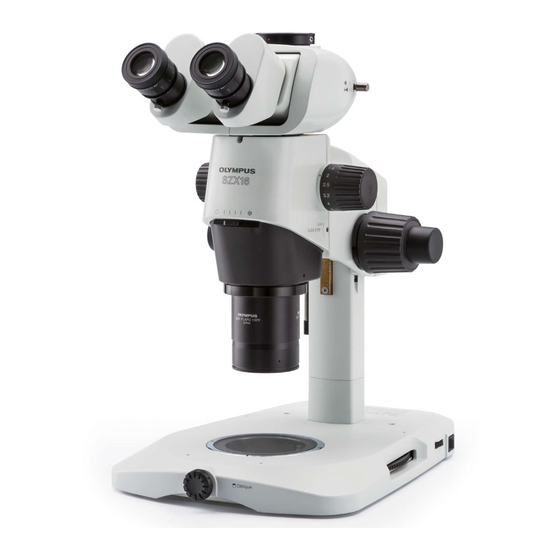- ページ 8
顕微鏡 Olympus SZX16のPDF 取扱説明書をオンラインで閲覧またはダウンロードできます。Olympus SZX16 28 ページ。 Research high-class stereo microscope
Olympus SZX16 にも: 概要 (24 ページ), 取扱説明書 (36 ページ), 取扱説明書 (40 ページ)

OBSERVATION
CAUTION
³
²
Fig. 1
|
Fig. 2
5
Fig. 3
²
Fig. 4
5
Always use a zoom magnification of 1X or more. The peripheral part of the illumination field will be
shaded under lower magnifications.
For the operating methods of the controls on the zoom microscope body, refer to the instruction
manual for the SZX16.
6
1
@
2
@
Fluorescence Observation
1. Pull out the shutter slider @ fully to the "shutter in" condition for the sake
of safety.
2. Rotate the filter turret ² to engage the desired filter in the light path. The
filter being engaged in the light path can be confirmed at position ³.
}See "
3
Combinations and Applications of Fluorescence Filters"
on page 6.
3. Set the main switch | of the power supply unit to " I " (ON).
The arc will stabilize in 5 to 10 minutes after ignition of the burner.
If you have not yet adjusted the centering of the mercury burner, center it
now (pages 13 to 15).
4. Place the specimen on the center of the stage plate 5.
}If transmitted light observation is not required, set the stage plate so that
the black side faces up.
If autofluorescence is noticeable, use the black plate of the optional SP-
FL fluorescence center plate.
If transmitted light observation is also performed, use a glass center plate.
If autofluorescence is noticeable during this, use the glass plate of the
optional SP-FL .
5. Push in the shutter slider @ to the empty or either ND filter position, bring
the specimen into focus and observe it.
}Adjust the collector lens focusing knob 6 as required.
}If the illumination is too bright, engage an ND filter in the shutter slider
into the light path.
}When fluorescence microphotography is required, all of the observation
light can be led to the TV/photo light path by using the optional SZX2-
TR30PT or SZX2-TTRPT trinocular observation tube with the 100% TV/
photo light path.
Transmitted Light Observation
1. Pull out the shutter slider @ fully to the "shutter in" condition.
2. Rotate the filter turret ² to engage the dummy filter position in the light
path.
3. Bring the specimen into focus and observe it.
(Figs. 1 to 3)
(Fig. 4)
